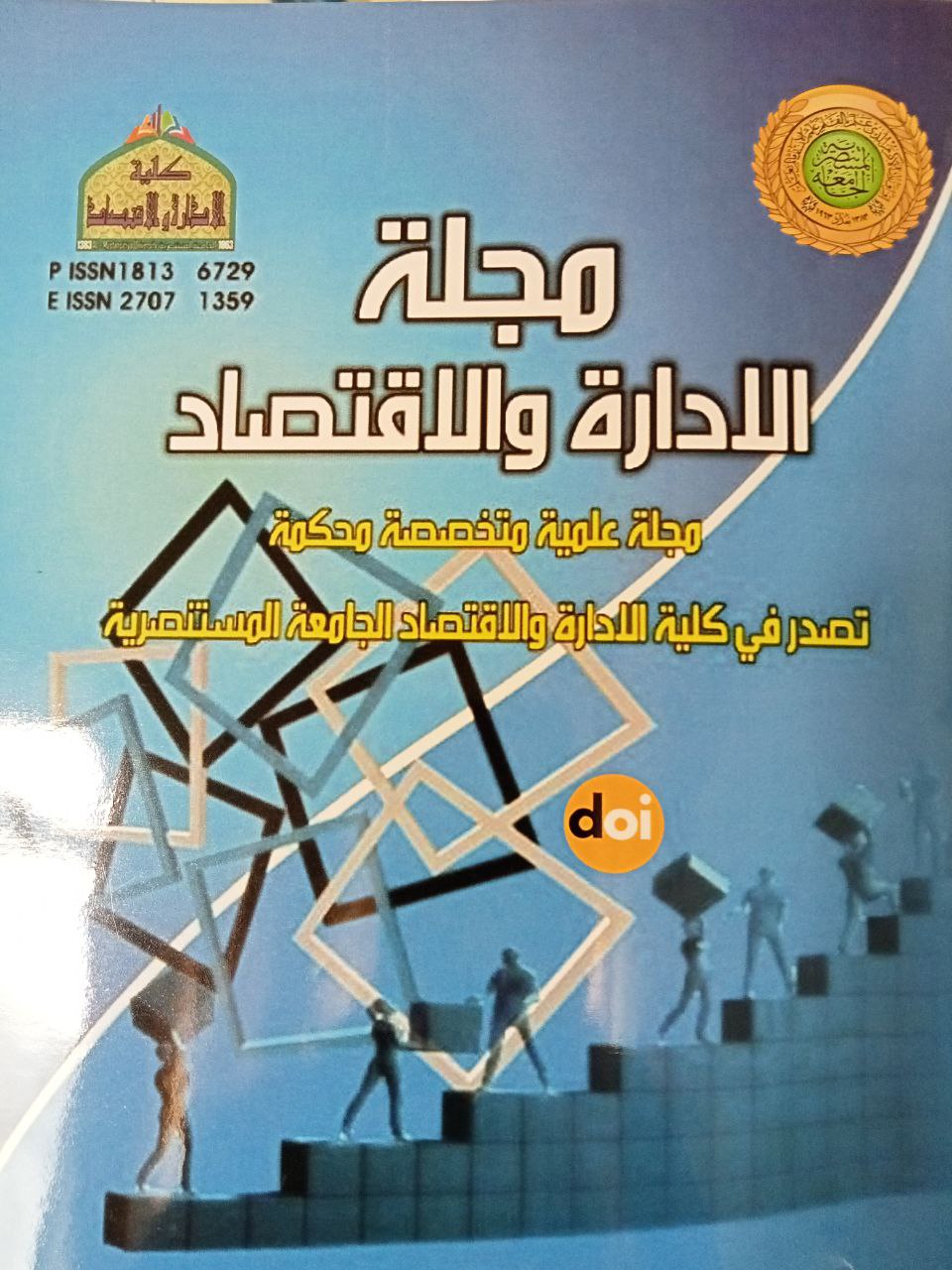تقدير الانموذج الوبائي (COVID-19) بالاعتماد على منظومة المعادلات التفاضلية المتعددة
DOI:
https://doi.org/10.31272/jae.i134.1210الكلمات المفتاحية:
انموذج (SIRD)، عدد التكاثر الاساسي، COVID-19، الاوبئة، المربعات الصغرى اللاخطية.الملخص
يتناول البحث استخدام احد نماذج الاوبئة هو انموذج (SIRD) ( معرضين للاصابة S – مصابين I – متعافين R – متوفين D ) والذي يتكون من نظام من المعادلات التفاضلية متعددة (ODE) لتغطية البيانات الخاصة بانتشار وباء كورونا في العراق للفترة من تاريخ اول حالة اصابة في (24 \ 2 \ 2020) حتى (22 \ 2 \ 2022) ، وتتم تقدير معلمات الانموذج وفقا لطريقة المربعات الصغرى اللاخطية للبيانات المبلغ عنها وايضا التنبوء بتطور تفشي الوباء ، كما تم تحديد معلمة مهمة في النماذج الوبائية هي عدد التكاثر الاساسي) ( هو العدد المتوقع للحالات الثانوية التي ينتجها الشخص المصاب في وقت مبكر من الوباء، و تبين من النتائج انحسار انتشار الوباء نتيجة اخذ اللقاحات وزيادة الاجراءات الوقائية المتبعة .
المراجع
for coronavirus disease outbreak 2019 (COVID-19) in Algeria Al-Raeei, M. (2021). The basic reproduction number of the new coronavirus pandemicd with mortality for India, the Syrian Arab Republic, the United States, Yemen, China, France, Nigeria and Russia with different rate of cases. Clinical epidemiology and global health, 9, 147-149.
Al-Raeei, M., El-Daher, M. S., & Solieva, O. (2021). Applying SEIR model without vaccination for COVID-19 in case of the United States, Russia, the United Kingdom, Brazil, France, and India. Epidemiologic Methods, 10(s1).
Al-Raeei, M. (2021). The COVID-19 basic reproductive ratio using SEIR model for the Middle East countries and some other countries for two stages of the disease. Bulletin of the National Research Centre, 45(1), 1-7.
Behl, R., & Mishra, M. (2020). COVID-19 lifecycle: predictive modelling of states in India. Global Business Review, 21(4), 883-891.
Calafiore, G. C., Novara, C., & Possieri, C. (2020). A time-varying SIRD model for the COVID-19 contagion in Italy. Annual reviews in control, 50, 361-372.
…………..Cereda, G., Viscardi, C., Gherardini, L., Mealli, F., & Baccini, M. (2021). Dynamics of contagion and submerged infections during the second wave of the SARS-CoV-2 epidemic in the Italian regions.q
Ferrari, L., Gerardi, G., Manzi, G., Micheletti, A., Nicolussi, F., Biganzoli, E., & Salini, S. (2021). Modeling provincial covid-19 epidemic data using an adjusted time-dependent sird model. International Journal of Environmental Research and Public Health, 18(12), 6563.
Hasanli, R. (2021). A data driven epidemic model to analyze and forecast the dynamics of COVID-19 (Master's thesis, Middle East Technical University).
Korolev, I. (2021). Identification and estimation of the SEIRD epidemic model for COVID-19. Journal of econometrics, 220(1), 63-85.
Ogana, W., Juma, V. O., & Bulimo, W. D. (2021). A SIRD model applied to COVID-19 dynamics and intervention strategies during the first wave in Kenya. medRxiv.
Pei, L., & Zhang, M. (2021). Long-Term Predictions of COVID-19 in Some Countries by the SIRD Model. Complexity, 2021.
Pan, J., Gray, A., Greenhalgh, D., & Mao, X. (2014). Parameter estimation for the stochastic SIS epidemic model. Statistical Inference for Stochastic Processes, 17(1), 75-98.
Sameni, R. (2020). Mathematical modeling of epidemic diseases; a case study of the COVID-19 coronavirus. arXiv preprint arXiv:2003.11371.
Samsuzzoha, M. D. (2012). A study on numerical solutions of epidemic models (Doctoral dissertation, PhD thesis).
Sedaghat, A., Band, S., Mosavi, A., & Nadai, L. (2020, November). Predicting Trends of Coronavirus Disease (COVID-19) Using SIRD and Gaussian-SIRD Models. In 2020 IEEE 3rd International Conference and Workshop in Óbuda on Electrical and Power Engineering (CANDO-EPE) (pp. 000267-000274). IEEE.
Sedaghat, A., Band, S., Mosavi, A., & Nadai, L. (2020, November). Predicting COVID-19 (Coronavirus Disease) Outbreak Dynamics Using SIR-based Models: Comparative Analysis of SIRD and Weibull-SIRD. In 2020 IEEE 3rd International Conference and Workshop in Óbuda on Electrical and Power Engineering (CANDO-EPE) (pp. 000283-000288). IEEE.
Sen, D., & Sen, D. (2021). Use of a modified SIRD model to analyze COVID-19 data. Industrial & Engineering Chemistry Research, 60(11), 4251-4260.
Tsay, C., Lejarza, F., Stadtherr, M. A., & Baldea, M. (2020). Modeling, state estimation, and optimal control for the US COVID-19 outbreak. Scientific reports, 10(1), 1-12.
TSEGA, E. Fitting an Epidemiological Model to Transmission Dynamics of COVID-19. Journal of Mathematical Sciences and Modelling, 3(3), 135-138.
Wacker, B., & Schlüter, J. (2020). Time-discrete parameter identification algorithms for two deterministic epidemiological models applied to the spread of COVID-19.

التنزيلات
منشور
إصدار
القسم
الرخصة
مجلة الإدارة والاقتصاد هي مجلة مفتوحة المصدر حيث تكون جميع محتوياتها مجانية. تخضع مقالات هذه المجلة لشروط ترخيص المشاع الإبداعي المنسوب إلى المؤلف (CC-BY 4.0) (https://creativecommons.org/licenses/by/4.0/legalcode) الذي يسمح للمرخص لهم دون قيود بالبحث عن النص الكامل للمقالات أو تنزيله أو مشاركته أو توزيعه أو طباعته أو ربطه به، وفحصه للفهرسة وإعادة إنتاج أي وسيلة للمقالات بشرط أن ينسبوا إلى المؤلفين الفضل في ذلك (الاستشهاد). تسمح المجلة للمؤلفين بالاحتفاظ بحقوق الطبع والنشر لمقالهم المنشور.
. Creative Commons-Attribution (BY)









